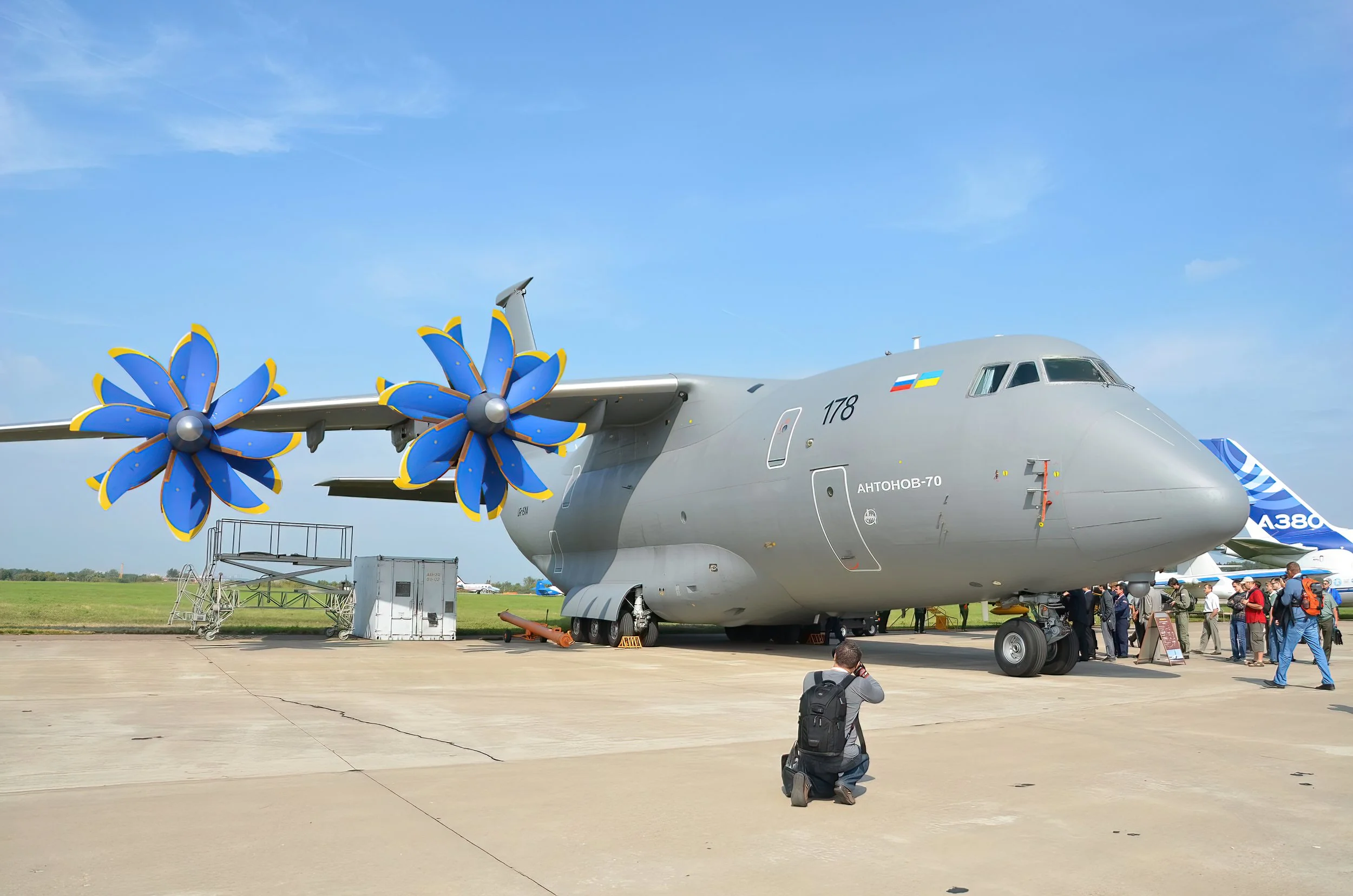
December 16 / Antonov An-70 first flight
First Flight 16 December 1994
Antonov An-70
The Antonov An-70 is a remarkable four-engine medium-range transport aircraft that holds a significant place in aviation history as the first aircraft to take flight powered exclusively by propfan engines. Its development began in the late 1980s by the renowned Antonov Design Bureau, with the primary aim of replacing the aging An-12 military transport aircraft. The An-70’s journey from conception to its current status is a tale of innovation, collaboration, and challenges, reflective of the geopolitical changes in Eastern Europe during the late 20th and early 21st centuries.
The An-70’s story begins in the mid-1970s when the Antonov Design Bureau initiated preliminary design work on a successor to the An-12, a four-engine turboprop aircraft that had served the Soviet Armed Forces for decades. By the 1980s, the Soviet military sought a more modern transport aircraft that could complement the Ilyushin Il-76 jet transporter. The new aircraft needed to possess quick loading capabilities, operate from short and unprepared airfields, carry up to 300 troops, and maintain operational economy. In 1987, the Soviet Ministry of Defence formalized these requirements, setting the stage for the An-70’s development.
The initial contract for the An-70 was signed in May 1989, and Antonov began advanced design work that same year. However, the collapse of the Soviet Union in 1991 brought significant challenges to the project. The newly independent states of Russia and Ukraine agreed to jointly develop the An-70, with Russia expected to provide the majority of the funding. Despite these efforts, the project faced numerous hurdles, including financial constraints and design challenges. The weakened national currency in Ukraine and the complex geopolitical landscape further complicated the development process.
Construction of the first An-70 prototype commenced in Kyiv in 1991, but financial and design issues delayed its maiden flight until December 16, 1994. The aircraft’s first flight was a milestone in aviation history, marking the debut of an aircraft powered solely by propfan engines. The flight, however, was not without its challenges. Engineers identified problems with the engine gearboxes, necessitating an eight-week grounding for repairs.
Tragically, the first prototype was lost in a mid-air collision during its fourth flight on February 10, 1995. This incident, caused by human error, resulted in the loss of the aircraft and the lives of the seven-member test crew. Despite this setback, Antonov converted a static-test prototype into a flying prototype, which made its first flight in April 1997.
The An-70’s development continued amidst a backdrop of political and economic uncertainties. The aircraft’s potential was recognized beyond the borders of Ukraine and Russia, with Western European countries, including Germany, evaluating it for procurement. Antonov even proposed a “westernized” version of the An-70, known as the An-7X, to cater to the European market. However, despite its technical merits, the An-70 faced stiff competition from other aircraft in development, such as the Airbus A400M.
In the early 2000s, the An-70’s future remained uncertain. A crash landing during cold weather testing in 2001 further delayed the project. Despite initial commitments from Russia and Ukraine to mass-produce the aircraft, funding issues and shifting political priorities hindered progress. Russia’s interest in the project waned, and by 2006, the country officially withdrew from the An-70 program.
The An-70’s design is notable for its innovative use of propfan engines, which offer significant fuel efficiency advantages over conventional turboprops. The aircraft’s high-mounted wings and supercritical airfoil design enhance its performance, allowing it to operate from short and unprepared runways. The An-70’s cargo hold is spacious and versatile, capable of carrying a wide range of military and civilian payloads.
Despite its challenges, the An-70 remains a testament to Antonov’s engineering prowess and the collaborative spirit of its creators. The aircraft’s development journey reflects the broader geopolitical shifts in Eastern Europe and the complexities of international aerospace projects. As of today, the An-70 continues to be a symbol of innovation and resilience in the face of adversity, offering valuable lessons for future generations of aircraft designers and engineers.
An-70 Facts
Pioneering Propfan Technology: The Antonov An-70 is the first aircraft to take flight powered exclusively by propfan engines, which are known for their fuel efficiency and performance advantages over traditional turboprops.
Development Origins: The An-70 was developed by the Antonov Design Bureau in the late 1980s to replace the An-12 military transport aircraft, aiming to meet the evolving needs of the Soviet Armed Forces for a modern, versatile airlifted.
Maiden Flight: The An-70’s maiden flight took place on December 16, 1994, in Kyiv, Ukraine, marking a significant milestone in aviation history despite initial technical challenges.
International Collaboration: Following the dissolution of the Soviet Union, the An-70 became a joint project between Russia and Ukraine, with both countries contributing to its development and funding.
Tragic Setback: The first prototype was lost in a mid-air collision in February 1995, resulting in the deaths of the seven-member test crew. This incident was later attributed to human error.
Western Interest: Several Western European countries, including Germany, evaluated the An-70 for potential procurement, and a “westernized” version called the An-7X was proposed to meet European requirements.
Design Features: The An-70 features a high-mounted wing design, four propfan engines, and a spacious cargo hold capable of carrying up to 47 tonnes of payload, making it suitable for a variety of military and civilian missions.
Production Challenges: Despite initial plans for mass production, financial constraints, political shifts, and technical issues delayed the An-70’s entry into service, with Russia eventually withdrawing from the project in 2006.
Innovative Materials: The An-70 incorporates advanced materials, including carbon-fibre composites and titanium, to reduce weight and enhance durability, with about 25% of the airframe made from composites.
Legacy and Impact: The An-70 remains a symbol of innovation and resilience, reflecting the complexities of international aerospace collaboration and the shifting geopolitical landscape of Eastern Europe in the post-Soviet era.







